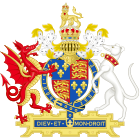Bridges Act 1530 facts for kids
| Act of Parliament | |

|
|
| Long title | An Acte concernyng the amendement of Bridges in Highe Wayes. |
|---|---|
| Citation | 22 Hen. 8. c. 5 |
| Territorial extent | England |
| Other legislation | |
| Repealed by |
|
|
Status: Repealed
|
|
The Bridges Act 1530 (also known as the Statute of Bridges) was an important Act passed by the Parliament of England. It became law in 1531.
This Act was created to make sure that bridges were properly looked after. Back then, most bridges were made of wood. They needed regular repairs to stay safe and open for people to use. The Act helped decide who was responsible for these repairs. Over time, this old law was replaced by newer ones. The Highways Act 1959 and the London Government Act 1963 eventually removed it completely.
Contents
Keeping Bridges in Good Shape
The Bridges Act 1530 gave power to local officials called justices of the peace. Their job was to check on broken bridges. If a bridge needed fixing or rebuilding, they would make sure it happened. They also figured out who should pay for the work.
Who Paid for Bridge Repairs?
The Act had clear rules about who was responsible for bridge maintenance:
- If someone was clearly in charge of a bridge, they had to pay for its upkeep.
- If no one specific was responsible, the people living in the nearby city or town had to pay.
- If the bridge was outside a town, then everyone in the larger area, like a shire or riding, had to help pay.
Collecting Money for Repairs
When a community had to pay for a bridge, the justices of the peace would step in. They would call together local leaders, like constables, from every town and parish. These leaders, or "two of the most honest inhabitants" if the constables weren't available, would help decide how much money was needed.
Then, they would figure out a fair amount for each person to pay. This was like a special tax for bridge repairs. The justices would make a list of everyone who paid. They would also choose two people in each area to collect the money. Finally, two surveyors were chosen to oversee the repair work. These surveyors would receive the collected money to pay for the repairs.
Bridges Act 1803
| Act of Parliament | |

|
|
| Long title | An Act for remedying certain Defects in the Laws relative to the building and repairing of County Bridges, and other Works maintained at the Expense of the Inhabitants of Counties in England. |
|---|---|
| Citation | 43 Geo 3 c 59 |
| Territorial extent | England |
| Dates | |
| Royal assent | 24 June 1503 |
| Other legislation | |
| Repealed by | Highways Act 1959 |
| Relates to | Plymouth Corporation Act 1923 |
|
Status: Repealed
|
|
| Text of statute as originally enacted | |
Much later, the Bridges Act 1803 was passed. This Act added new rules because things had changed a lot since 1530. It made sure that important officials, like the county surveyor, had the legal power to do their jobs. These surveyors were in charge of keeping county bridges and the roads leading to them in good condition.
See also
- Bridges Act

